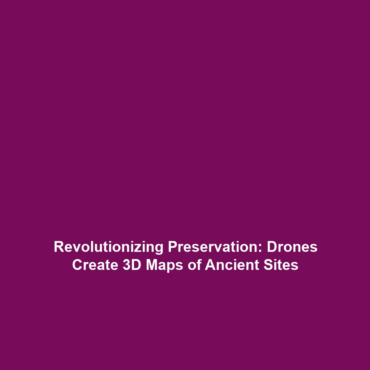<>
Drones Used to Create Detailed 3D Maps of Ancient Sites for Preservation Purposes
Introduction
The integration of drones in science has opened new avenues for researchers and archaeologists, particularly in the meticulous mapping and preservation of ancient sites. Drones equipped with advanced imaging technology enable the creation of detailed 3D models that serve both to document historical locations and facilitate their preservation. This innovative application of drones is critical in a world where many ancient landmarks are under threat from environmental and human-induced factors.
Key Concepts
Drones used to create detailed 3D maps of ancient sites for preservation purposes involve several key concepts:
- Photogrammetry: A technique that captures multiple images of an object from different angles to create accurate, high-resolution 3D models.
- LiDAR Technology: Light Detection and Ranging technology is used by drones to assess distances by illuminating a target with laser light, producing precise topographical maps.
- GIS Integration: Geographic Information Systems are tools used alongside drone imaging to analyze spatial data and aid in conservation efforts.
The importance of these technologies lies in their ability to contribute to the preservation of cultural heritage within the broader category of drones in science.
Applications and Real-World Uses
Numerous practical applications exist for drones in the context of 3D mapping of ancient sites:
- Site Documentation: Drones facilitate comprehensive surveys of archaeological sites, capturing every detail of their structure.
- Monitoring Changes: Drones can regularly survey sites to detect changes over time, allowing for proactive preservation measures.
- Virtual Reconstructions: Detailed maps allow for virtual reality models, making these sites more accessible to the public while protecting their physical integrity.
These applications underscore how drones are used in the preservation of ancient sites, showcasing their significance within the discipline of drones in science.
Current Challenges
Despite their advantages, the application of drones for 3D mapping comes with challenges:
- Regulatory Issues: Navigating the legal landscape governing drone use can be complex and restrictive.
- Technical Limitations: High-quality mapping requires advanced technology that can be costly and not universally accessible.
- Data Management: Storing and analyzing the large volumes of data generated by drones can pose significant logistical challenges.
These challenges of using drones for 3D mapping impact the efficacy and efficiency of preservation strategies.
Future Research and Innovations
Ongoing research is poised to enhance the capabilities of drones in mapping ancient sites:
- AI Integration: Artificial intelligence could improve the processing of data collected by drones, making it more intuitive and faster.
- Enhanced Sensors: Next-generation sensors will facilitate higher-resolution images and better vehicle autonomy.
- Collaborative Platforms: Developing shared networks for data collection and analysis may foster greater cooperation among archaeologists and scientists.
These innovations will significantly impact the future of drones in science, enabling more efficient and precise methods for site preservation.
Conclusion
Drones used to create detailed 3D maps of ancient sites for preservation purposes represent a transformative approach in both archaeological research and cultural conservation. Their ability to provide comprehensive insights and proactive measures for preservation embodies their critical role in the field of drones in science. As technology advances, further exploration and implementation of these methods will be essential. For further reading on the intersection of technology and archaeology, visit our articles on using drones for environmental monitoring and the role of GIS in cultural preservation.


